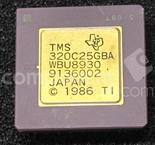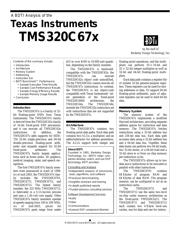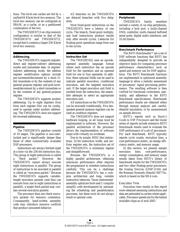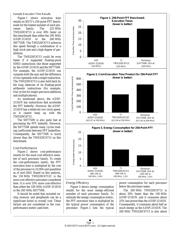Datasheet 搜索 > DSP数字信号处理器 > TI(德州仪器) > TMS320C25GBA 数据手册 > TMS320C25GBA 其他数据使用手册 3/4 页

¥ 1451.208
TMS320C25GBA 其他数据使用手册 - TI(德州仪器)
制造商:
TI(德州仪器)
分类:
DSP数字信号处理器
封装:
CPGA-68
描述:
TMS320第二代数字信号处理器 TMS320 SECOND GENERATION DIGITAL SIGNAL PROCESSORS
Pictures:
3D模型
符号图
焊盘图
引脚图
产品图
TMS320C25GBA数据手册
Page:
of 4 Go
若手册格式错乱,请下载阅览PDF原文件

Page 3
© 2003 BDTI (www.BDTI.com). All rights reserved.
0
100
200
300
400
500
600
0
5
10
15
20
25
ADI
TI
TMS320C6713
Renesas
SH7750R (SH-4)
(685 mW at
(895 mW at
(285 mW at
ADSP-21161N
Figure 3. Energy Consumption for 256-Point FFT
(lower is better)
E
n
e
r
g
y
(
w
a
t
t
-
m
i
c
r
o
s
e
c
o
n
d
s
)
200 MHz, 1.2V)
100 MHz, 1.8V)
200 MHz, 1.5V)
0
5
10
15
20
25
30
Sample Execution Time Results
Figure 1 shows execution time
results on BDTI’s 256-point FFT bench-
mark for the fastest member of each pro-
cessor family. The 225 MHz
TMS320C6713 is over 30% faster on
this benchmark than either the 100 MHz
ADSP-21161N or the 240 MHz
SH7750R. The TMS320C6713 achieves
this speed through a combination of a
high clock rate and a high degree of par-
allelism.
The TMS320C6713 could be even
faster if it supported floating-point
SIMD instructions like those supported
by the ADSP-21161N and the SH7750R.
For example, the ADSP-21161N can
compute both the sum and the difference
of two operands with a single instruction.
The TMS320C6713 is also held back by
the long latencies of its floating-point
arithmetic instructions (for example,
four cycles for single-precision additions
and multiplications).
As mentioned above, the ADSP-
21161N has instructions that accelerate
the FFT butterfly. However, the ADSP-
21161N has a relatively low clock speed,
so it cannot keep up with the
TMS320C6713.
The SH7750R is also quite fast at
processing the FFT butterfly. However,
the SH7750R spends many cycles load-
ing coefficients between FFT butterflies.
Consequently, the SH7750R is much
slower than the TMS320C6713 on this
benchmark.
Cost-Performance
Figure 2 shows cost-performance
results for the most cost-effective mem-
ber of each processor family. To create
the cost-performance metric, the FFT
execution time is multiplied by the cost
of the processor in 10,000-unit quantities
as of mid-2003. Based on this analysis,
the 150 MHz TMS320C6712C is the
most cost-effective processor considered
here. It is over 35% more cost-effective
than either the 100 MHz ADSP-21161N
or the 200 MHz SH7750R.
It should be noted that included on-
chip memory and peripherals can be a
significant factor in overall cost. These
factors are not considered in the cost-
performance metric used here.
Energy Efficiency
Figure 3 shows energy consumption
results for the most energy-efficient
member of each processor family. To
estimate the energy consumption metric,
the FFT execution time is multiplied by
the typical power consumption of the
processor. Figure 3 lists the typical
power consumption for each processor
below the processor name.
The 200 MHz TMS320C6713 is
about 30% faster than the 100 MHz
ADSP-21161N, and it consumes about
25% less power than the ADSP-21161N.
Consequently, it consumes about half as
much energy as the ADSP-21161N. The
200 MHz TMS320C6713 is also about
Execution Times
Figure 1. 256-Point FFT Benchmark
(lower is better)
ADI
TI
TMS320C6713
Renesas
SH7750R (SH-4)
(225 MHz)
(100 MHz)
(240 MHz)
ADSP-21161N
ADI
TI
TMS320C6712C
Renesas
SH7750R (SH-4)
($13.50 at 150 MHz)
($21.67 at 100 MHz)
($17.65 at 200 MHz)
ADSP-21161N
Figure 2. Cost-Execution Time Product for 256-Point FFT
(lower is better)
E
x
e
c
u
t
i
o
n
T
i
m
e
(
m
i
c
r
o
s
e
c
o
n
d
s
)
C
o
s
t
-
E
x
e
c
u
t
i
o
n
T
i
m
e
(
m
i
c
r
o
s
e
c
o
n
d
-
$
)
器件 Datasheet 文档搜索
AiEMA 数据库涵盖高达 72,405,303 个元件的数据手册,每天更新 5,000 多个 PDF 文件





